|
Vatican View: Facts |
|
Return
to Vatican View | Vatican
View: Q & A
|
|
 |
Facts: Papacy, Vatican, Rome & More...
Sources:
Various
Important
Notice: Information
herein is not comprehensive and may include details that are
unverifiable/debatable, approximations, etc. All applicable items are
subject to change. We make no guarantees regarding any item herein. By
using this site you agree to all terms. For more terms information,
click here.
|
|
Click
link below or scroll down to view all:
|
Item |
Fact(s) |
|
Address of
the Pope |
According a diocesan source, one may write to
the Pope at the following address:
His
Holiness Pope (N.*)
Apostolic
Palace
00120
Vatican City State, Europe
*
Replace N. with name of Pope (including Roman numerals, if any)
[The salutation inside the letter should read
"His Holiness" (no "Dear", and no
other title or name)]
Note: Mailing address may be subject to change.
For current mailing address, e-mail address, etc., try the Vatican
website (see Catholic
Web Links Section). To report an address correction,
click here.
|
|
Antipopes |
Definition of Antipope: "One claiming to
be pope in opposition to a true pope canonically elected."
(Catholic Dictionary)
For a list of antipopes, click
here |
|
Avignon Papacy |
The Avignon Papacy refers to the period of time in
the 14th century (1309-1377) where the papacy was moved from Rome to
Avignon France. Pope Clement V moved the papacy under
imperial pressure, beginning the seventy year 'Babylonian Captivity'
(referring to Israel's exile) which lasted until the papacy was returned
to Rome by Pope Gregory XI on January 17, 1377. There were a total of 7
Popes during this period: Pope Clement V, Pope John XXII (XXI), Pope
Benedict XII, Pope Clement VI, Pope Innocent VI, Pope Bl. Urban V, and
Pope Gregory XI.
|
|
Camerlengo |
The Camerlengo is the chamberlain of the Church.
He is considered the "most important official" of the
Church during an interregnum (period of time between death of a
pope and election of another pope). Upon the death of a pope, he
administers Church properties, heads congregations, and makes preparations
for the conclave. He also certifies the death of a
pope and destroys the pope's ring (used for sealing documents -
the destruction of which protects against fraudulent documents and
"symbolically extinguishes the pope's power").
|
|
Canonized
(& Blessed) Popes /
Feast Days |
For list of canonized / beatified popes
(A-Z), click
here For feast days for canonized /
beatified popes (Jan.-Dec.), click
here |
|
Cardinals |
Definition: "A member of the Sacred
College of Cardinals, the counsellors and assistants of the pope
in the government of the Church". (Catholic Dictionary)
Cardinals are "permanent advisors and holders of the exclusive
right to elect the pope". They serve on various Roman
Congregations and wear a red hat. After the death of a Pope, they
conduct Masses for the deceased pope, assist in governing the
Church, and elect a new Pope in a conclave. There are three ranks
of Cardinals: Cardinal-bishop, Cardinal-priest, and
Cardinal-deacon. The rank of Cardinal is said to date back to the
early 4th century. Note: Click here
for 'Reflections' related to this topic. |
|
The Chair of
Peter |
The "Chair of Peter" may refer to
the office of the papacy (click
here), or to the Pope's infallibility - e.g. speaking "ex
cathedra" (click
here), or to the actual chair (Latin: cathedra) believed to have been used by
St. Peter.
|
|
Churches in Rome |
It has been said that "there are more churches in Rome than days of
the year". For a list of some of Rome's churches & catacombs, click
here. Note: Also see other listings herein (e.g. St. Peter's
Basilica, St. Mary Major, St. John Lateran, etc.)
|
|
Conclave |
Definition: "Conclave (Lat. cum
clave, with a key). The assembly of cardinals for the election of a
pope; also the place where the assembly meets." (Catholic
Dictionary) A conclave is a secret proceeding which begins 15-20
days after the death of a pope. The balloting takes place in the
Sistine Chapel and continues until a new pope is elected. The
Cardinal Electors are sequestered from contact
with the outside world, and are literally locked within the walls
during the process of electing a pope (thus derives the name
"conclave"). A 2/3 majority vote is generally required to elect a pope. Once a new
pope is chosen and he
accepts, he
becomes pope immediately (if he is not a bishop, however, he must be ordained a bishop).
To signal the results of elections, ballots are burned in a stove
which produces smoke visible from outside. White smoke signals the
election of a new pope, whereas black smoke signals that a new pope
has not been elected. Note: Click here
for 'Reflections' related to this topic. Also
See: Election of a Pope
| Death
of a Pope / Election of a Pope (Q & A) | Election
of a Pope (Reflections) |
|
Deposed / Abdicated / Overthrown Popes
|
For information concerning popes who
abdicated or were deposed / overthrown, click
here
|
|
Dicastery |
Definition: "An office or collection of
departments such as that of the congregations, etc. forming the
Roman Curia, sometimes called the Pontifical Dicastery"
(Catholic Dictionary) The dicasteries, headed by a Cardinal,
support the Roman Pontiff.
|
|
Election of a Pope |
After the death of a pope, the Church enters
a period called sede vacante (Latin for "vacant
see") or papal interregnum (derived from Latin, meaning "period between the reign
of popes").
During an interregnum, the Church is governed by the College of
Cardinals [although their powers are limited and certain items
limited to the Pope must wait (e.g. appointment of bishops,
convening synods of bishops, canonizing saints, etc.)]. There is a
period of mourning, Masses are said for the deceased pope, and
the deceased pope is buried. Within the prescribed number of
days, the Cardinal Electors meet in a conclave (see
above) and elect a new pope. ("Theoretically, any baptized
layman in good standing who is not a heretic or schismatic may be
elected pope, but the man chosen will most likely be a Cardinal
Elector.") Hundreds of years ago, the clergy and people of Rome
helped choose the pope, but this method sometimes led to serious
disagreements and even fights. Eventually, the orderly process of a conclave was adopted and
popes have since been chosen by
Cardinal Electors. In recent years, the election process has
usually been relatively rapid. However, in the past, some
interregnums have been quite lengthy (one in the 13th century
lasted nearly three years) as a result of wars, rivalries, civil
disturbances, or even the Cardinals themselves (who were said to
enjoy the power and financial rewards of running the Church). When
the Cardinals elect a pope in a conclave, he is asked if he accepts. If so, he becomes pope
immediately (if he is
not a bishop, he must be ordained a bishop immediately).
Shortly afterwards, the great joy of a new pope is announced (in
Latin) from the central balcony of St. Peter's: "I announce
to you a great joy. We have a pope! (Habemus papam!)", Then
the pope's baptismal name and chosen papal name are given. Soon after, pope gives his Urbis et Orbi
["to the city (Rome) and to
the world"] blessing, his first blessing as pope. Also See: Conclave
| Death
of a Pope / Election of a Pope (Q & A) | Election
of a Pope (Reflections) |
|
"The Great" Popes |
For more information regarding "the
Great" popes [St. Leo I, St. Gregory I, St. Nicholas I
(often Called 'the Great')], click
here |
|
Holy
See |
The term "Holy See" (Sancta Sedes
in Latin, "Holy Seat") refers to the episcopal see of
Rome. It may also refer to the Pope and the Roman Curia, the
Church's central administration / government. The Holy See
administers the independent Vatican City State (click
here). The Holy See may also be called "the Apostolic
See" (although this title may also refer to other sees
founded by an Apostle).
Also See: Vatican
View: Q & A |
|
Important Dates in Papal History |
Some important dates in papal history
include:
|
Date |
Event |
|
c.
33 |
Institution
of Papacy by Christ with St. Peter as first pope |
|
c.
34-37 |
Martyrdom
of St. Peter and St. Paul in Rome |
|
312
|
Constantine
wins battle of the
Milvian Bridge
|
|
313 |
Edict
of Milan issued, "legalizing" Christianity
in the Roman Empire |
|
320
|
Building of first St. Peter's Basilica
|
|
325 |
First
Ecumenical Council of Nicaea |
|
800 |
Charlemagne crowned emperor at St.
Peter's
|
|
1309
|
Papacy moved to Avignon (France)
|
|
1377
|
Papacy returned to Rome
|
|
1870
|
Confiscation of
the Papal States
|
|
1870
|
Proclamation of Papal Infallibility |
|
1929 |
Lateran Treaty signed (creating
separate Vatican City State) |
Note:
Not comprehensive.
For
other events in papal history, try here. Also
See: The
Papacy in History (Q & A) |
|
Lenten Station Churches (Rome) |
For information concerning Lenten station
churches, click
here |
|
Magisterium |
Deriving from the Latin "magister"
(master), "Magisterium" refers to the Church's teaching authority which was granted by Christ. As defined: "The
Church's divinely appointed authority to teach the truths of
religion, 'Going therefore, teach ye all nations...teaching them to
observe all things whatsoever I have commanded you' (Matt. xxviii,
19-20). This teaching is infallible: 'And behold I am with you all
days, even to the consummation of the world' (ibid.). The solemn magisterium
is that which is exercised only rarely by formal and authentic definitions
of councils or popes. Its matter comprises
dogmatic definitions of oecumenical councils or of the popes teaching
ex cathedra, or of particular councils, if their decrees are universally accepted or approved in solemn form by the pope;
also creeds and professions of faith put forward or solemnly
approved by pope or oecumenical council. The ordinary magisterium is continually exercised by the
Church especially in
her universal practices connected with faith and morals, in the unanimous
consent of the Fathers and theologians, in the decisions of Roman Congregations
concerning faith and morals, in the common
sense of the faithful, and various historical documents in which
the faith is declared. All these are founts of a teaching which as
a whole is infallible. They have to be studied separately to determine
how far and in what conditions each of them is an
infallible source of truth." (Catholic Dictionary)
Since St. Peter has been given jurisdiction over the
Church, including the fellow apostles, the Papal
Magisterium is called a "Universal Magisterium". The
entire body of bishops may also claim an Universal Magisterium, but
only in union with the Pope.
Note: The term "perennial magisterium" may refer to the changeless / perpetual
teachings of the Church (although the composition of the
Magisterium has changed as persons depart, the teachings themselves
remain changeless / perpetual).
|
|
Main Catacombs |
Main Catacombs of Rome Include:
S.
Agnese
S.
Callisto
Domitilla
S.
Pietro e Marcellino
Priscilla
S.
Sebastiano Note:
For a listing of some of Rome's churches & catacombs, click
here |
|
Major
Penitentiary |
The Major Penitentiary is the head of the
Apostolic Penitentiary (the tribunal dealing with questions of conscience,
absolution, dispensations, indulgences, etc.). He is
"one of only two department heads who retain their office
upon the death of a pope" (along with the Camerlengo).
|
|
Majordomo |
"The official who formerly was head of the
papal household in the Vatican. The office was abolished in
1929." (Catholic Dictionary)
|
|
Papacy |
The papacy refers to the office of the pope
(e.g. "he was elected to the papacy") or to the reign of
a pope (e.g. "his papacy lasted 15 years"). Note:
Also see pontificate (click here).
Also See: Vatican
View: Q & A |
|
Papal Blessings |
Papal blessings are "a privilege
certifying that the Holy Father has bestowed his apostolic
blessing". They may be obtained to commemorate ordinations,
birthdays, anniversaries, etc. To obtain a papal blessing, contact
your parish, diocese, or applicable church or shop in Rome. There
may be various requirements (e.g. administration fee, official
letter attesting to the occasion, etc.) and, it should be noted, the process may take
some time.
|
|
Papal Documents ("Classic Encyclicals") |
For "Classic Encyclicals & Other
Papal Documents", click here or here
|
|
Papal Duties |
The Pope, as the Supreme Pastor, visible head
of the Church on earth, and the vicar of Christ, rules and governs
both the faithful and their pastors. He pronounces on matters of
faith and morals, legislates for the Church, creates/modifies
dioceses, confirms the election of bishops, canonizes saints,
absolves from certain sins, administers Church property, renders
judicial decisions, and conducts other important Church matters.
He may delegate some of his responsibilities to others, but his
infallibility is not transferable. Note: For "Papal Duties
/ Concerns" Reflections, click
here. |
|
Papal Infallibility |
For information concerning infallibility, click
here |
|
Papal Legates |
A legate is an "ecclesiastic representing
the Holy See and having a varying degree of its
authority." Note: For "Papal Legates"
reflections, click
here. |
|
Papal States |
The Papal States (also called the "Patrimony of St.
Peter) refer to lands ruled by the popes for more than a thousand
years before they were seized. The donated or acquired lands were
ruled by popes until they were ultimately seized by the Italian
forces in 1870. As a result of the forcible seizure, the reigning
pope, Bl. Pope Pius IX, began a self-imposed imprisonment in the
Vatican which continued throughout the rest of his long
pontificate and until the pontificate of Pope Pius XI. On February
11, 1929, the "Roman Question" was settled when Pope
Pius XI signed the Lateran treaty which established Vatican City as an
independent state (and gave extraterrestrial status to other
Church properties), and provided for remuneration for the
confiscated lands.
|
|
Papal Titles |
The Pope (Papa) may be called by various titles,
including:
*
Bishop of Rome
*
Roman Pontiff
*
Supreme Pontiff of the Universal Church
*
Successor of the Prince of Apostles
*
Vicar of Jesus Christ / Vicar of Christ
*
Primate of Italy
*
Patriarch of the West
* Archbishop and
Metropolitan of the Roman Province
*
Sovereign of the State of Vatican City
*
Father and Patriarch of the whole world
*
Sovereign Pontiff
*
Servant of the servants of God
*
Prince of Shepherds
* Supreme
Pontiff / Pontifex Maximus (P.M.)
*
Highest Pontiff
*
Most Holy Father / Holy Father
*
Most Blessed Father
*
His Holiness
*
Your Holiness
He has also been called the "Living Voice of
Christ". "[The pope's full
designation is:] Bishop of Rome, Vicar of Jesus Christ, Successor of the
Prince of the Apostles, Supreme Pontiff of the Universal Church,
Patriarch of the West, Primate of Italy, Archbishop and Metropolitan of
the Roman Province, and Sovereign of the State of the City of the
Vatican" (Catholic Dictionary) |
|
Papal Writings |
Papal writings come in a variety of types: Encyclicals, Papal Bulls,
Apostolic Letters, etc. The following are some definitions:
"APOSTOLIC LETTERS. One of the divisions of writings emanating
from the Curia Romana. An apostolic letter may be simplex
(i.e. one drawn up in the pope's name), a chirographum (signed by
the pope), and encyclical, or a motu proprio" (Catholic
Dictionary)
"BRIEF. A papal letter, signed by the secretary for
briefs and stamped with an impression of the pope's ring; it is a
less formal and weighty document than a bull" (Catholic
Dictionary)
"BULL, PAPAL. The most solemn and weighty form of papal letter, beginning '[Name], servant of the servants
of God' and formerly always sealed with a lead seal [from the
Latin bulla]" (Catholic Dictionary)
"CONSTITUTIONS.
i. Papal. In the strict sense, those communications of general
authority and applicability which the pope issues in his own name.
In the wide sense, it includes also decrees of the Roman Congregations."
(Catholic Dictionary)
"DECRETALS.
Decisions of the popes given in various forms on matters of
discipline, i.e. canon law, but not always binding on the whole Church. The
earliest decretals (more often called constitutions) were letters to bishops in reply to
questions or reports, which had
the force of law, so that all bishops of the Western church had
to have collections of them." (Catholic Dictionary)
"ENCYCLICAL. An encyclical letter is one addressed by
the pope to the patriarchs, primates, archbishops, bishops and
other ordinaries of the whole Church, or less often, to the hierarchy
of a particular country... Of late years the Roman pontiffs have more and more expressed their minds in this form of
utterance... Encyclicals are not necessarily infallible
documents, though the pope could choose to speak ex cathedra by
means of them if he wished to do so: but if they contain doctrinal
teaching Catholics are bound to give to them interior as well as exterior
assent and obedience." (Catholic Dictionary)
"MOTU PROPRIO (Lat., of his own accord). A rescript drawn up and issued by the pope on his own initiative,
without the
advice of others, and personally signed by him." (Catholic
Dictionary)
"RESCRIPT, PAPAL. The reply of the Holy See or a Roman
congregation to a question or request submitted to them. A rescript
usually only affects the person to whom it is addressed,
but sometimes has the force of a general law. Papal dispensations
are granted by rescript." (Catholic Dictionary)
Note that papal teachings may also take other
forms (e.g. Exhortations, Discourses, Audiences, Messages, etc.).
Papal writings may be ranked according to type (e.g. a Papal Bull is higher than a Papal Brief).
Also See: Classic
Encyclicals
|
|
Patriarchal Basilicas |
"The four greater or patriarchal basilicas at
Rome" (alphabetical
order):
S. Giovanni in
Laterano (St. John Lateran)
S. Maria Maggiore
(St. Mary Major)
S. Paolo Fuori
le Mura (St. Paul's Outside the Walls)
S.
Pietro (St. Peter's)
|
|
Pontificate |
The term 'pontificate' may refer either to
the office of the Supreme Pontiff or to his term of office. It may
be used synonymously with 'papacy' Note: Also see papacy (click
here)
Also See: Vatican
View: Q & A |
|
The Pope |
"The pope, as bishop of Rome, is the
successor of St. Peter, and therefore the visible head of the Church on
earth, the vicegerent of Christ, and the supreme ruler of all Christians.
Christ commanded Peter to 'feed my lambs, feed my sheep' (John xxi, 16,
17), which meant that he was to rule and govern the faithful and their
pastors. He is therefore the supreme judge in all matters of faith and morals, in
pronouncing upon which he may exercise infallibility. He also exercises
supreme jurisdiction and may legislate for the whole Church and dispense
from canonical law. He alone can erect, suppress, or otherwise modify
dioceses and mission territories; confirm the election of bishops or
translate or depose them; and fully approve new religious institutes. He
reserves to himself the beatification and canonization of saints and the
absolution of certain sins, and judges appeals from all lower
authorities. But he cannot alter the faith once delivered to the saints
or suppress or modify any essential rites or dispense from the divine
law. Much of the papal power may be and is delegated, e.g., to the Roman
congregations, delegates apostolic, and others." (Catholic Dictionary)
The pope is Christ's Vicar, the earthly leader of
the Catholic Church, and the successor of St. Peter. He also has
jurisdiction over the Vatican City State and the Holy See. He is the
Bishop of Rome and the Supreme Pontiff of the Catholic Church. His
office is called the pontificate (or papacy). As possessor of the keys
to the kingdom of heaven and gifted with infallibility, the pope keeps
the doctrine of the faith pure and acts as a center of unity in the
Church. His office is a royal one, as represented by the triple tiara
commonly worn by the popes. The pope also has his own Papal Coat of Arms
and military force (the Swiss Guards). The pope presently resides in the
Vatican palace and his official seat is the Basilica of St. John Lateran.
Note: The term 'pope' is derived from the Greek
'papa', or father. The term originally enjoyed a broader use (e.g. it
was applied to bishops and priests), but after a few centuries, it was
used exclusively to denote the Bishop of Rome.
Also See: Vatican
View: Q & A
|
|
The Popes: St. Peter to Present |
For information regarding the popes from St.
Peter to present, click
here |
|
Popes' Previous Names |
For information regarding the popes' previous
names (that is, their names before being elevated to the papacy), click
here |
|
Primacy / Supremacy |
The Pope has the highest authority in the
Church, and his supreme position is not shared by any other member
of the Church. For more information on papal primacy / supremacy, click
here (Papal Primacy / Supremacy Reflections) & visit the
Vatican View: Q & A (click
here). |
|
Roman Artwork |
Thanks to papal patronage, Rome contains
masterpieces from many of the world's greatest
artists. Some famous artists "shaping the face of Rome"
include:
*
Alessandro Algardi
*
Gian Lorenzo Bernini
*
Francesco Borromini
*
Bramante
*
Caravaggio
*
Domenichino
*
Carlo Fontana
*
Michelangelo Buonarroti
*
Pietro da Cortona
*
Raphael Sanzio
*
Carlo Rainaldi
*
Vignola
*
And more...
Also
See: Vatican Museums
|
|
Roman Curia |
"The totality of organized bodies which
assist the pope in the government and administration of the Church,
namely, the Congregations, the Tribunals and the Curial offices,
together with certain permanent commissions" (Catholic
Dictionary) Also See: Roman Curia
(Reflections) | Dicastery |
|
Roman Proverbs |
Over the years, various "Roman
proverbs" have developed. Some of the more popular ones include:
*
" Rome wasn't built
in a day"
*
" All roads lead to Rome"
*
" When in Rome,
do as the Romans do"
|
|
Roman Rota |
A court of appeal and one of three Roman
Tribunals (see below). Also See: Roman
Rota (Reflections) |
|
Roman Tribunals |
Definition: "A court of law of the Roman
Curia" (Catholic Dictionary).
The three tribunals are:
*
Apostolic Penitentiary (deals with questions of conscience,
absolution, dispensations, indulgences, etc.)
*
Apostolic Signatura (supreme court of the Church) *
Roman Rota (court of appeal)
|
|
Rome: Airports |
International Airports in Rome:
* Leonardo da Vinci (or Fiumicino) [Approx.
17 miles SW of Rome]
* G.B.
Pastine-Ciampino ("Rome's second main airport")
[At the foot of the Castelli Romani, approximately 9 miles SE of the city
center]
|
|
Rome: Patron Saints |
Patron Saints of Rome may include:
St.
Agnes
St.
Frances of Rome
St. Lawrence
St.
Paul the Apostle
St.
Peter the Apostle
St.
Philip Neri
Also See: Saints Section |
|
Rome: Seven Hills |
Rome's Seven Hills:
Aventino
(Aventine)
Caelio
(Celian)
Capitolino
(Capitoline) [smallest]
Esquilino
(Esquiline) [largest/highest]
Palatino
(Palatine)
Quirinale
(Quirinal)
Viminale
(Viminal) Note:
The Vatican is located on Vatican Hill, which is not one of Rome's
famous "seven hills". |
|
Rome: Temperature / Rainfall / Sunshine |
Avg. Temperature (min./max.) [F]:
|
Month |
Avg. Temp. (min./max.) |
Month |
Avg. Temp. (min./max.) |
|
January |
41 / 52
|
July |
68 / 86
|
|
February |
43 / 55
|
August |
63 / 81
|
|
March |
45 / 59
|
September |
55 / 70
|
|
April |
50 / 64
|
October |
48 / 61
|
|
May |
56 / 72
|
November |
48 / 61
|
|
June |
63 / 86
|
December |
43 / 54
|
|
Note: Rome's average maximum temperature
ranges from about 55 degrees (F) (Dec.-Jan.) to about 85 degrees
(F) (July-Aug.). Winters are considered "mild and
rainy", while summers are described as "hot and
dry". The "fiery heat" of July and August is
considered "unbearably hot".
Rome's
average daily hours of sunshine:
Ranges
from about 3 hours (Dec.-Jan.) to nearly 10 hours (June)
Rome's
average monthly rainfall:
Ranges
from about .25" (July) to nearly 4" (November), with
11 out of 12 months averaging about 1 inch or more |
|
Rome: Time |
"Rome is one hour ahead of GMT
[Greenwich Mean Time] in winter, one hour ahead of BST [British
Summer Time] in summer, six hours ahead of New York and nine
hours ahead of Los Angeles. Clocks are advanced one hour in April
and turned back one hour in October." [Source: AAA]
The following chart may be helpful:
|
24
HOUR TIME COMPARISONS* |
|
Rome |
GMT
(London)
[-1
hr] |
New
York
[-6
hrs] |
Los
Angeles
[-9hrs] |
|
When
it is ... in Rome* |
It
is ... in London* |
It
is ... in New York^ |
It
is ... in Los Angeles^ |
|
12:00
a.m. (midnight) |
11:00 p.m. |
6:00 p.m. |
3:00 p.m. |
|
1:00 a.m. |
12:00 a.m. (midnight) |
7:00 p.m. |
4:00 p.m. |
|
2:00 a.m. |
1:00 a.m. |
8:00 p.m. |
5:00 p.m. |
|
3:00 a.m. |
2:00 a.m. |
9:00 p.m. |
6:00 p.m. |
|
4:00 a.m. |
3:00 a.m. |
10:00 p.m. |
7:00 p.m. |
|
5:00 a.m. |
4:00 a.m. |
11:00 p.m. |
8:00 p.m. |
|
6:00 a.m. |
5:00 a.m. |
12:00 a.m. (midnight) |
9:00 p.m. |
|
7:00 a.m. |
6:00 a.m. |
1:00 a.m. |
10:00 p.m. |
|
8:00 a.m. |
7:00 a.m. |
2:00 a.m. |
11:00 p.m. |
|
9:00 a.m. |
8:00 a.m. |
3:00 a.m. |
12:00 a.m. (midnight) |
|
10:00
a.m. |
9:00 a.m. |
4:00 a.m. |
1:00 a.m. |
|
11:00
a.m. |
10:00 a.m. |
5:00 a.m. |
2:00 a.m. |
|
12:00
p.m. (noon) |
11:00 a.m. |
6:00 a.m. |
3:00 a.m. |
|
1:00 p.m. |
12:00 p.m. (noon) |
7:00 a.m. |
4:00 a.m. |
|
2:00 p.m. |
1:00 p.m. |
8:00 a.m. |
5:00 a.m. |
|
3:00 p.m. |
2:00 p.m. |
9:00 a.m. |
6:00 a.m. |
|
4:00 p.m. |
3:00 p.m. |
10:00 a.m. |
7:00 a.m. |
|
5:00 p.m. |
4:00 p.m. |
11:00 a.m. |
8:00 a.m. |
|
6:00 p.m. |
5:00 p.m. |
12:00 p.m. (noon) |
9:00 a.m. |
|
7:00 p.m. |
6:00 p.m. |
1:00 p.m. |
10:00 a.m. |
|
8:00 p.m. |
7:00 p.m. |
2:00 p.m. |
11:00 a.m. |
|
9:00 p.m. |
8:00 p.m. |
3:00 p.m. |
12:00 p.m. (noon) |
|
10:00
p.m. |
9:00 p.m. |
4:00 p.m. |
1:00 p.m. |
|
11:00
p.m. |
10:00 p.m. |
5:00 p.m. |
2:00 p.m. |
|
* Note: Subject to
change. Note that above may vary with changes in DST (Daylight
Savings Time). Note that dates and amounts of time shifts may
vary. For example, around the time of death of Pope John Paul II
in 4/05, Californians might have noticed a 10 hour time difference,
rather than 9 hours as shown above. This is because Rome
transitioned to Daylight Savings Time on 3/27/2005, whereas
California transitioned to Daylight Savings Time on 4/3/2005.
|
|
Rome: Travel Info.
Note: We do not endorse any particular
travel plan. Contact a good travel agent for assistance with
travels. |
"Best and most popular time to visit
Rome": September and October
"Possibly the worst time to visit
Rome": November ("the wettest month of the year,
with possible strong and heavy rainstorms")
"Rome
in a Day" / "Vatican City in a Day":
A
popular travel agency's suggestion for "visiting Rome in a
day" includes: Piazza Venezia, Monumento a Vittorio Emanuele II,
Colonna Traiano, Piazza del Campidoglio, Santa Maria in Aracoeli, Roman
Forum, Colosseum, Arco di Constantino, Colle Oppio, Via di San Giovanni
in Laterano, San Clemente, Via dei Santi Quattro Coronati, San Giovanni
in Laterano. The travel agency also recommends visits to Basilica di San
Pietro (St. Peter's) and Museo Vaticano (Vatican Museums). Similar travel
agency suggestions for "visiting Vatican City in a Day"
include the Vatican
Museums, Sistine Chapel, Stanze di Raffaello, Museo Pio-Clementino, and
St. Peter's.
Some
Roman Streets:
Highlighted
streets in at least one popular travel guide include: Via Appia
Antica (near catacombs, "best known Roman road, parts of which
remain from more than 2000 years ago"), Via del Corso ("key street"),
Via Guilia ("one of the most elegant streets in Rome"),
and Via Veneto ("formerly Rome's most fashionable
street").
Planning
a Trip with Spiritual Value:
Note
that Rome is full of "tourist attractions" of all sorts
(historical, cultural, artistic, etc.). Catholics would be wise to
consider the spiritual value of their travels as well, considering
the unparalleled assortment of Catholic historical sites, relics,
Catholic churches & basilicas, etc. available in and near this
area. Consider contacting your diocese or favorite Catholic
organization for planned trips and/or suggestions.
Warning for tourists: Unfortunately,
Vatican City State has a high
crime rate (especially due to the low number of residents there). In
Rome and the vicinity, one must be especially careful for pickpockets
and purse snatchers. It is said that "most such crimes remain
unresolved." Note: Consult appropriate agencies for
assistance in planning a "safe trip".
Also See: Rome:
Airports | Rome:
Temperature
|
|
Rome: Misc. |
Misc.
Roman Facts Include:
*
Rome is said to be over 3,000 years old, "one of the most ancient
European cities"
*
Rome was known as the "Caput Mundi"
("the head / center / capital of the world")
*
"Rome was first the headquarters of the Roman
Empire and then the Catholic Church"
*
Rome is also known as the "Eternal City" and "Holy
Rome" ("Roma Santa")
*
Rome is the "Capital of Christianity"
*
Rome is the capital of Italy
*
"Rome is the only city in the world that can
claim to be a capital three times over. Besides being the capital of
Italy, it contains the Vatican State and the Sovereign Order of the
Knights of Malta."
*
"Rome's area is about
580 square miles, with a population density in the province of Rome of
1,839 people per square mile."
*
"Official population count of Rome": Over 2.6 million
(1997) (it is said that the actual count may be nearly double)
*
As many as 3.6 million U.S. tourists annually
visit the province of Rome.
*
Rome has had a significant impact on the world in various areas, especially
legal, political, and architectural ("many
legal and political systems follow the ancient Roman model and much
architecture is based on techniques perfected in ancient Rome")
*
"Rome contains a wealth of history, dating from the beginnings of
Christianity" (and earlier)
*
"In Rome, there is a coexistence of sacred and
profane"
*
Rome has a connection with many saints and martyrs, even dating back
from the martyrdoms of St. Peter and St. Paul, who were both martyred in
Rome.
*
Public holidays in Rome may include: New Year's Day
(1/1), Epiphany (1/6), Easter Sunday / Easter Monday, Ss. Peter and Paul's day (6/29),
Assumption (8/15), All Saint's Day (11/1), Immaculate
Conception (12/8), Christmas (12/25), and St. Stephens (12/26)
*
Information regarding the U.S. Embassy in Rome may be found
online, or you may try the following:
U.S.
Embassy in Rome
Via Veneto
Tel.
L 06 46 74 1
Note:
Address/telephone and all other information subject to change.
Information is provided for your convenience. We are not
affiliated with or responsible for this third party organization.
To report an address correction, click here.
Also
See: Rome (Reflections)
|
|
Rome's Churches & Catacombs |
Note:
For a list of some of Rome's churches & catacombs, click
here
Note: Also see other listings herein (e.g. St. Peter's
Basilica, St. Mary Major, St. John Lateran, etc.) |
|
Santa Scala |
Originally called Scala Pilati, the 28 marble
stairs are traditionally believed to have been ascended by Our
Lord Jesus during his trial under Pontius Pilate. Although they originally
led to Pontius Pilate's office, they were removed from there in the early
days of Christianity as an object of veneration. They were since
located in Rome where they are ascended prayerfully by pilgrims - and
popes! - on their knees. Now covered in wood, these stairs "reddened
with the blood of Christ" are located near St. John Lateran. Although some call these stairs "falsely identified",
tradition supports the authenticity of the stairs as do written
sixth century accounts. Further, it is said that the marble used
was a common type used at Jerusalem at the time and that the steps
had been known to be missing. These holy stairs have been called
"an essential stop for pilgrims in Rome".
|
|
Seven
Churches of Rome |
"The Seven Churches of Rome":
*
St. Peter's (S. Pietro)+
*
San Giovanni in Laterano (St. John Lateran)+
*
San Paolo Fuori le Mura (St. Paul's outside the Walls)+
*
Santa Maria Maggiore (St. Mary Major)+
*
Santa Croce in Gerusalemme (Holy Cross in Jerusalem)
*
San Lorenzo Fuori le Mura (St. Lawrence outside the Walls)
*
San Sebastiano Fuori le Mura (St. Sebastian outside the Walls)
+
Denotes Major basilica/patriarchal basilica
Also
See: St.
Peter's Basilica | St. John Lateran |
St. Mary Major
| St.
Paul Outside the Walls
|
|
St. John Lateran (San Giovanni in
Laterano) |
San Giovanni in
Laterano (St. John Lateran) is the cathedral church in Rome and the patriarchal basilica of the
Roman Pontiff. It was built in the 4th century and is called the "Mother
Church of Christendom". It was given to the Church by Constantine,
and was formerly the residence of the popes (before the
Avignon Papacy). It is located on one of the "seven hills of
Rome" and is extra-territorially a part of
the Vatican City State. It is one of the four great Roman
Basilicas. It was richly adorned by various popes and other
benefactors, and became known as "the golden basilica."
During the years, it has suffered attack, earthquakes, and fires,
causing it to be rebuilt various times. It
houses an altar believed to have been used by St. Peter to
celebrate Mass.
|
|
St. Mary Major (Santa Maria
Maggiore) |
Basilica di Santa Maria Maggiore (St. Mary Major), "The
world's largest church dedicated to the
Blessed Virgin Mary" and one of the four major basilicas in Rome is also thought to be the oldest church in
Rome dedicated to the Blessed Virgin. It
is a "church of many names", having also been called the Liberian Basilica,
Santa Maria
ad Praesepe ("St. Mary of the Crib"), and St. Mary of the
Snow. Although it suffered damage during the years (e.g.
by earthquakes), it is reputed to be "the only Roman
basilica to have retained its original core". Its original
founding is associated with a miraculous event in the fourth
century. According to tradition, Our Lady caused the snow to fall
in the middle of summer to mark the spot for the basilica in
response to a pious, wealthy couple's desire to donate their possessions
to the Church. Both the couple and the pope (Pope Liberius) had a
dream regarding Our Lady's desire for the a church to be built.
The miraculous summer snowfall occurred in August and the basilica
was subsequently built in that location. The miraculous event is
commemorated annually at the basilica by the showering of flower
petals. St. Mary Major is home to important mosaics and various
other "art treasures". It is said that the gilded ceiling
was made of gold believed to be the first
brought from America by Columbus. The basilica is used by the
pope on several important occasions each year (e.g. for Mass on the Feast of
the Assumption).
|
|
St.
Paul Outside-the- Walls (S. Paolo Fuori le Mura) |
St. Paul outside-the-walls (also called
"St. Paul without-the-walls) is the second
largest basilica in Rome (after St. Pietro) and one of the four
Major Basilicas of Rome. It is the location of St. Paul's tomb (near the
site of his martyrdom). The original basilica was built by
Constantine. Since then, it has suffered damage from earthquakes and
fire and has undergone much rebuilding. Until the construction of
the new St. Peter's Basilica, it was the largest basilica in
Rome.
|
|
St. Peter |
St. Peter, originally called Simon, was one
of the earliest followers of Jesus. Upon seeing Simon, Jesus
renamed him "Peter" (see Jn. 1:42), which means
"rock". The name change was significant, since St. Peter
would become the "rock" upon which Jesus would build his
Church (see Mt. 16:18). In Holy Scripture, St. Peter, the Prince of the Apostles, was
promised the papacy by Our Lord Jesus Christ after confessing
Christ as the Son of God:
"When
Jesus went into the region of Caesarea Philippi he asked his
disciples, 'Who do people say that the Son of Man is?' They
replied, 'Some say John the Baptist, others Elijah, still others
Jeremiah or one of the prophets.' He said to them, 'But who do you
say that I am?' Simon Peter said in reply, 'You are the Messiah,
the Son of the living God.' Jesus said to him in reply, 'Blessed
are you, Simon son of Jonah. For flesh and blood has not revealed
this to you, but my heavenly Father. And so I say to you, you are
Peter, and upon this rock I will build my church, and the gates of
the netherworld shall not prevail against it. I will give you the
keys to the kingdom of heaven. Whatever you bind on earth shall be
bound in heaven; and whatever you loose on earth shall be loosed
in heaven.'" (Mt. 16:13-19)
After His Resurrection, Christ confirmed St.
Peter as the Supreme Pastor of His flock (the first pope), and on Pentecost,
St. Peter began immediately to assume this role. Eventually, St. Peter
would move to Rome and be martyred there in the year 64 or 67.
Since St. Peter's death, there have been an unbroken line of
successors to his pontifical throne. Also
See: St. Peter (Reflections) |
Authority / Supremacy
(Q & A) | Vatican View:
Q & A | Pope
(Topical Scripture) | Papal
Infallibility |
|
St. Peter's Basilica (Basilica di San
Pietro) |
The Basilica di San Pietro (St. Peter's Basilica),
is considered the "world's most famous church" and
"the largest church in the world". It was built over the tomb of St.
Peter, the first pope, who was crucified there, upside down, in 64/67
A.D. The present structure, dating from the sixteenth century,
replaced an earlier basilica built by Constantine (which had previously
replaced a shrine that had been there). In the present basilica,
St. Peter's tomb lies beneath the high altar (which was recently
confirmed by excavations). The present structure utilized the
talents of famous artists such as Michelangelo,
Bramante, and Bernini. It contains various important works of art,
as well as many altars, tombs, and monuments. Its famous dome has
been called the "largest dome in the world" and the basilica
itself is visited by an estimated 10 million people per year. Many
important Church functions are held there (including canonizations).
Located in front of Peter's Basilica is St. Peter's
Square, "the world's most beautiful public place". St. Peter's
square is flanked by Bernini's famous colonnades (two half circles
of colonnades, symbolic of arms stretched out to embrace), which
are ultimately topped by well over 100 statues of saints. Enclosed within are
two fountains and a huge
obelisk (which contains a fragment of the True Cross).
St. Peter's Basilica adjoins the Vatican
Palace, the residence of the pope and home to the Vatican Museums.
|
|
St. Susanna (Santa Susanna) |
Santa Susanna is the national church of American
Catholics in Rome. It has been called "a home away from home for
English speaking people living in Rome".
|
|
Swiss Guards |
"The corps of papal guards responsible
for the custody of the outer doors and gates of the Vatican Palace
and City and of the personal apartments of the pope, whom they
also attend at all functions." (Catholic Dictionary) The
Pontifical Swiss Guard dates from the beginning of the sixteenth
century.
Although the Swiss Guards are considered
"the most famous army in the world" and "the oldest continuous military corps in existence",
they have not fought in battles for hundreds of years (and were
even required to lay down their arms by papal command on several
occasions).
It is commonly believed that the
colorful Swiss Guard uniform (gold, red, yellow, and blue) was designed by Michelangelo, but the
Vatican website has said that "It is commonly thought that the
uniform was designed by Michelangelo, but it would seem rather that he had
nothing to do with it."
|
|
Tour of the Seven Churches |
St. Philip Neri / Tour of the Seven Churches
Includes:
S.
Pietro
S.
Paolo Fuori le Mura
S.
Sebastiano Fuori le Mura
S.
Giovanni in Laterano
S.
Croce in Gerusalemme
S.
Lorenzo Fuori le Mura
S.
Maria Maggiore |
|
Vacant Seat /
Sedevacantist |
The Church enters a period of sede vacante
(Latin for "empty seat") after the death of a pope. This
period continues until the election of a new Roman Pontiff. By
contrast, schismatic Catholics who assert that there has
been
no canonically elected pope for many years are called Sedevacantists.
Note: The Sedevacantists maintain that there has been no
canonically elected pope since the 1960's and essentially claim
that only the small number that recognize this 'situation' are in
the true Church.
Also See: Election of a Pope |
Conclave |
|
Vatican Address / Website |
For the Vatican mailing address, click
here
For the Vatican website, try the Catholic
Web Links section |
|
Vatican City
(Citta del Vaticano) |
Vatican City (or Vatican City State), located
in southern Europe,
is the location of the Vatican ("the official residence of the Pope and
the administrative center and world headquarters of the
Catholic Church"). It is considered "the smallest
independent nation state in the world by size and
population". It is surrounded by Rome, Italy and takes its
name from Vatican Hill [Latin: Mons
Vaticanus (predating Christendom), not one of the famous seven
hills] where it is situated. Vatican City is the location of
St. Peter's Basilica (click
here), the Vatican Museums (click
here), and the papal palace. It is governed by the Holy See (click
here).
This area has a long history, including the
burial of St. Peter there in the first century after his
martyrdom. In the fourth century, the land was given by
Constantine to the Pope, where the first basilica was erected over
St. Peter's grave, literally "built on St. Peter". Years
later, the area would become the residence of the Pope, and in
1929, after the confiscation of the papal states and after many
years of "prisoner popes" the sovereignty of the Vatican
State was finally recognized with the signing of the Lateran
Treaty (February 11, 1929). The treaty also granted extraterritorial
status to various other areas [including
San Giovanni in Laterano, San Paolo fuori le Mura and Santa Maria
Maggiore, and Castel Gandolfo (the summer residence of the pope)].
Additional Vatican City Facts:
* The pope is the Head of State of the
country of Vatican City. [Note: Despite being called
"Vatican 'City'", Vatican City is actually a country.]
*
Vatican City is roughly triangular in shape and is less than one fifth of a square mile
in size (about 109 acres).
*
Vatican City may have just a few hundred permanent residents and a thousand total residents
(many of its
citizens are clergy or nuns, with much of its population being
male).
*
Vatican City is said to have a "zero birth rate".
*
Vatican City is considered "the most visited
state in Europe", receiving several millions pilgrims
annually.
*
The official language of Vatican City is Latin (Italian may also
be commonly spoken).
*
Vatican City mints its own coins.
*
Vatican City issues its own postage stamps.
*
Vatican City has its own flag.
*
Vatican City has its own Internet country code (.va).
*
Vatican City has its own legal system.
*
Vatican City has its own post office.
*
Vatican City has its own diplomats.
*
Vatican City is guarded by the Swiss Guards (click
here).
In addition to having "more phones in
proportion to its population than any other city or nation on
earth", Vatican City also has its own radio station,
publishing house, newspaper, and television studio.
It also houses chapels
(including the famous Sistine Chapel, with its renowned ceiling painted by Michelangelo), courtyards, gardens, museums
(click here), government offices of the Church, and the Vatican Library
(click
here). The Papal Palace (or Palace of the Vatican) is said
to contain more than 1,000 rooms. Many famous artists and architects
worked on the Vatican's buildings. Vatican
City is separated from the Republic of Italy by a white line.
Vatican City is supported by
a variety of sources, including contributions from Catholics
worldwide (Peter's Pence), tourist mementos, admission fees,
investment income, and other profits. Although Vatican City is
home to many priceless treasures, they are said to have "no
market value" since the Church will not sell them, but
instead preserves them for the benefit of the faithful and of the
world at large. In fact, maintaining these treasures is quite
costly, and the number of items that must be cared for is "constantly increasing".
Also See: Holy See
| Location
of Popes / Vatican (Q & A) |
|
The Vatican Flag |
"The Church's banner
originally featured the figure of St. Peter on a red background. Pope
Innocent III replaced the figure with symbolic keys surmounted by a
white cross; and Boniface VIII opted for a red silk standard spangled
with gold stars. The flag remained unchanged until 1824, when Leo XII
gave it the colors it has today, yellow and white; the keys have been
crowned by the papal tiara ever since." (Rome)
The Flag of Vatican City contains one vertical band
of yellow, and one vertical band of white. Crossed keys of silver and
gold and the papal tiara appear on the white band. Note: There is
probably at least one of these flags in your parish (e.g. in the
sanctuary).
|
Graphical Representation of
the Vatican Flag:
(not
an exact image)
|
 |
|
|
Vatican Library / Biblioteca Apostolica
Vaticana |
The Vatican Library (Biblioteca Apostolica Vaticana) contains
a "priceless collection of ancient
manuscripts and more than one million bound volumes" and "easily rates as the world's most valuable
collections of books and manuscripts".
|
|
Vatican Museums |
Vatican Museums are considered
"outstanding" and "home to some of the most beautiful
art in the world". They are considered "one of the world's
richest and largest collection of paintings, sculptures and other
works of art accumulated by the papacy over the centuries".
The art is considered to be of the "highest historical and cultural
importance". The museums originated with the collection of
sculptures by Pope Julius II
in the early 16th century. Today, parts of the Vatican are open to
visitors, including rooms, galleries, chapels, and museums. Items
on display may include antiquities, sculptures, vases, lapidary, paintings,
tapestries, artifacts, ceramics, mosaics, religious art,
historical portraits, monuments, carriages/vehicles, old
topographical maps, etc. Tours
of the various items may be available [and may include the famous
Sistine Chapel (named after its founder, Pope Sixtus IV)]. Popes are credited with promoting culture and art history by being among
the first rulers to open art collections to the public.
|
|
Vatican
Publications |
Vatican publications may include:
Acta Apostolicae
Sedis - "Vatican's official newspaper". Includes
documents, legislation, etc. in Latin as well as some writings in
their original language. "Technically no Vatican document is ever officially
promulgated until it appears in the Acta Apostolicae Sedis"
Annuario Pontificio
(Pontifical Annual/Pontifical Yearbook) - An annual directory of the Holy
See containing names of cardinals bishops, priests, dioceses,
statistics, etc.
L'Osservatore
Romano - "Vatican City's 'semiofficial' daily
newspaper". A daily newspaper in Italian with some items in their original
languages. The paper is considered "influential far beyond
the city walls". Note: There are weekly editions of this paper in
various languages. The Vatican
Information Service (VIS) "[provides] electronic daily news service in
real time of activities of the Holy Father and the Holy See".
The Vatican also has a website, radio station, and television
center.
Note: The printing press of the Vatican was
formerly called the Vatican Polyglot Press, but it was renamed in
1991 to the Vatican Press. The Vatican's publishing operations are
considered "extensive" with its books and other
published items being sold all over the world.
Reminder: Above items not comprehensive.
All items subject to change.
Also See: Vatican Radio
|
|
Vatican Radio |
The Vatican radio station (HVJ/Radiogiornale)
was designed by the inventor of the radio (Marconi), and had its
first broadcast in 1931. It now transmits hundreds of hours of
programming in dozens of languages each week to its global audience. It has been called "one of the
most influential [radio stations] in
Europe". Note: In addition to the radio station,
the Vatican Television Center (CTV) was created in 1983.
Also See:
Vatican Publications
|
|
Vicar of
Christ |
"Vicar of Christ" is a synonym for Pope, who acts in the name of Christ with the authority given him
by Christ. The Pope is also called the Supreme Pontiff, Holy
Father, etc. Note: Click here
for more papal titles.
|
|
Misc. |
Sedia Gestatoria - A portable papal throne
for carrying the Pope on solemn entries
Mirabilia Urbis Romae - "Rome's first
guidebook", dating from the twelfth century.
"Biblioteca Angelica" - Rome's
first public library (founded in 1614)
Santa Maria Sopra Minerva - "Rome's
only Gothic church"
Obelisk of Piazza di San Giovanni in Laterano -
"Most ancient & tallest obelisk in Rome"
Churches in Rome that may admit animals on certain
days - Click here
for information on this topic (St.
Francis section)
|
Top
| Vatican View Section | Vatican
View: Q & A | Vatican
View Reflections
Have
a request for this page? Please tell us! Click here for submission terms and instructions.
Note:
Please submit only general requests
regarding the Pope/Papacy or Vatican which are NOT subject to
change (e.g. NO requests regarding the current Pope, the
current curia, current pronouncements, etc.). Please do not request
items which are already covered here or on the Q & A page.
Please submit only non-trivial items which would appeal to a wide
audience. Thank you.
|
By using
this site you indicate agreement to all terms. For terms information,
see "Important Notice" above and click
here.
|
|
|
|
|
|
|
|
|
Catholic Books & Ebooks
Click Here
|
|
Reflections (Wisdom From Popes & Saints)
Click Here
|
|
'Quick Help' Pages
Click Here
|
|
Need Help?
'Live Chat'
Click Here
|

Home
MCS Daily Digest
Quick Guide to This Site
What's New
Reception Desk
Notices
Topic Pages
'Quick Help' Pages
Books / Ebooks |
Kindle Scribe Books
Apps
Reflections
Help |
'Live Chat'
Coming Soon
Featured Sections
URL Shortcuts
Calendar
Goals / Purpose
This site is really free?
How can I add a "post" here?
Mission Statement
Privacy Statement
Imprimatur Information
Terms of Use
by using this site, you agree to all terms
MCS Directory
Community Center
Commercial Areas
Non-Catholics
About Us
FAQs
Tell a Friend
Invite a Business
Link to Us
My Catholic Source.com Blog & RSS Feed Info.
Third Party Programs
Awards
Feedback
Contact Us
This site powered by
bfsnet.com

|
|
Now Available!
Catholic Word Search - JUMBO Edition
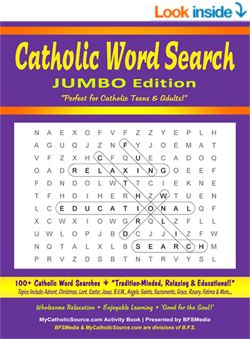
(Original)
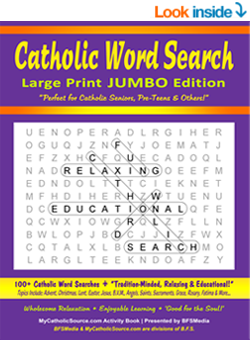
(Large Print Edition)
100+ Catholic Word Searches (Incl. Advent,
Christmas, Lent, Easter, Jesus, B.V.M., Angels, Saints, Sacraments, Grace, Rosary, Fatima, And More...)
"Relaxing, educational, good
for your memory, mind, focus, vocabulary, and good for your soul!"
Get Your Copy Today!
Also
Available...
Catholic
Word Search - Bilingual Edition: Latin / English
Search Words In Latin, Meanings In English

55 Catholic Word Searches ~ "Tradition-Minded,
Relaxing & Educational!"
Topics Include: Advent, Christmas, Lent,
Easter, Jesus, B.V.M., Angels, Saints, Sacraments, Rosary & More...
"Perfect For Catholic
Teens & Adults!" ~ "Great For Home Schoolers!"
Get Your Copy Today!
Why Latin? / Latin Info.
Click link or image above for more information & to purchase.
And...
Catholic
Word Search - Bilingual Edition: French / English
Search Words In French, Meanings In English
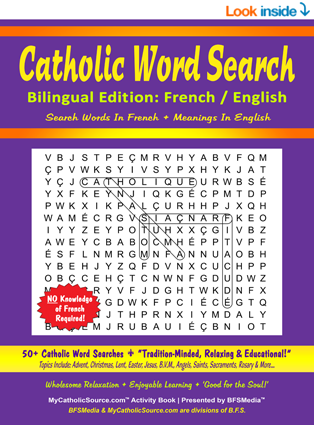
Absolutely NO Knowledge Of
French Is Required!
50+ Catholic Word Searches ~ "Tradition-Minded,
Relaxing & Educational!"
Topics Include: Advent, Christmas, Lent,
Easter, Jesus, B.V.M., Angels, Saints, Sacraments, Rosary & More...
"Perfect For Catholic Teens & Adults!" ~ "Great
For Home Schoolers!"
Fun for any time! Also great for...
* Planning a Catholic pilgrimage to France
* Learning some (or brushing up on some) French
words
* Increasing your French vocabulary
* Adding fun to a homeschool curriculum
* Enjoying a unique challenge, even if you
don't speak a word of French!
Free Sample Here
Get Your Copy Today!
Why Learn French?
Click link or image above for more information & to purchase.
Now Available!
4
Great Inspirational Catholic Coloring Books...




Plus These Handy Coloring Books & Resources...

Lots of Love Coloring Book (Vol.1) - 40 Love-Themed / Affirming Coloring Pages (Easy/Fairly Easy) - "Includes a Variety of Coloring Pages Suitable for Children or Adults!" ~ "Great for Sharing!"

My Colors - Easy & Convenient Color Sample
Sheets ~ Coloring Resources Book: 125+ Assorted Color Sample Sheets - "Perfect
For Testing, Selecting & Organizing Pen, Marker, Pencil or Crayon Colors!"

My Colors 2 - Easy & Flexible Color
Combination Grids ~ Coloring Resources Book: 50+ Color Sample Sheets In 3 Grid
Sizes - "Perfect For Previewing, Testing & Selecting Pen, Marker, Pencil Or
Crayon Color Combinations!"
[Please Note: Proceeds from sales of these books may support My Catholic Source.com]
For More Information & To
Purchase, Click Image(s) Above
Click Here For Coloring Examples
Now Available!
700+ Consoling Thoughts From Holy Scripture
"Inspirational & Uplifting!"
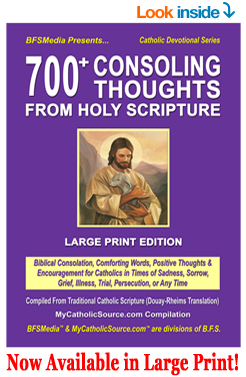
"Some of the most consoling
& comforting words from Holy Scripture, all in one place!"
+ + +
Compiled From Traditional Catholic Scripture
(Douay-Rheims Translation)
Get it today!
+ + +
For More Information & To
Purchase, Click Link Below...
Kindle Version Just $7.99
Notice: Prices are subject to change
without notice and do not include any applicable taxes.
Now Available!
The iStations Book - Stations of the Cross

Two Traditional Way of the
Cross Methods for Catholics Based on Our 'Best Selling' App
Features beautiful images, TWO traditional
methods, including a Franciscan method, selected prayers in English & Latin
Get it today!
For More Information & To
Purchase, Click Link Below...
Kindle Version Just $4.99
Notice: Prices are subject to change
without notice and do not include any applicable taxes.
Now Available!
Catholic Annual Prayer Book
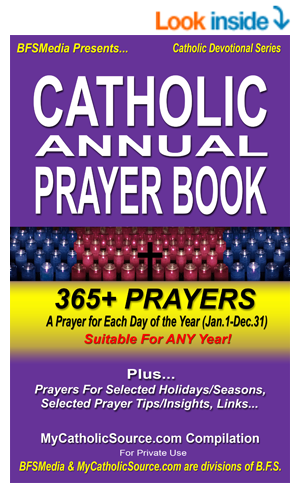
Includes: 365+ Daily Prayers (Jan.-Dec.);
Holiday / Seasonal Prayers; Hundreds of Prayers Indexed by Title;
Nearly 200 Aspirations / Short Prayers; Over 100 Latin Prayers & Aspirations; 500+
Topics for Meditation; Hundreds of Prayer Tips & Insights; And More...
Includes prayers drawn from Holy Scripture, the
liturgy, writings of popes & saints, the Raccolta, the Roman Breviary, the Roman
Missal, etc.
A daily prayer companion for
Catholics that is 'suitable for any year'!
Kindle Version Just $8.99
Notice: Prices are subject to change
without notice and do not include any applicable taxes.
Click Here to Buy
Now Available!
Coloring Book For Catholics: 50+ Latin
Prayers
(Beginning - Intermediate - Advanced)
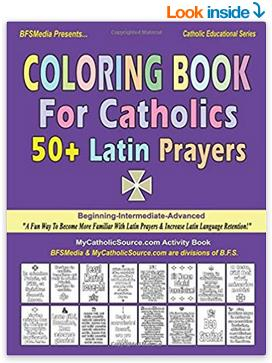
"This 'unique', tradition-minded coloring book
which contains some of the most popular Catholic prayers in Latin is a fun way
to become more familiar with Latin prayers & increase Latin language retention!"
This 'educational & fun' publication is useful
for prayerful relaxation, educational recreation ('learn while you play'),
becoming more familiar with Latin prayers & hundreds of Latin words, learning or
memorizing Latin prayers, increasing Latin retention, and more...
An enjoyable and
instructive tool with respect to Latin (the 'beautiful & majestic language of
heaven' and 'official language of the Church' - a language 'consecrated' by the
inscription on the Cross that helps to foster a universal bond in prayer with
Catholics around the world), this publication is suitable for Catholics of most any
age.
+ + +
"This Catholic coloring book
- which provides hours of wholesome & educational recreation - is so much better
for your soul than television!"
+ + +
Notice: Prices are subject to change
without notice and do not include any applicable taxes.
Click Here to Buy
Now Available!
My Little Latin Mass Coloring Book

25+ Traditional Latin Mass Coloring Images For Children Or Adults [Low
Mass]
"Enjoyable & Educational!"
+ + +
Notice: Prices are subject to change
without notice and do not include any applicable taxes.
Click Here to Buy
Catholic Classics Reprint Now Available!
In Heaven We Know Our Own - Or, Solace for
the Suffering
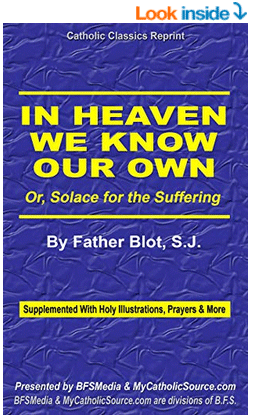
This 'Catholic Classic', which offers consoling
'proof' that the faithful departed remember, love & care for those in heaven and
for those still remaining on earth, is a "great balm of comfort" to those who
have lost a spouse, child, parent, friend, or other loved one. "A thoughtful
bereavement gift, and a 'must-have' for grieving Catholics!"
Get your copy today!
For More Information & To
Purchase, Click Link Below...
Kindle Version Just $2.99!
Notice: Prices are subject to change
without notice and do not include any applicable taxes.
Now Available!
Setting The Record Straight About Luther
Important Things Catholics Should Know About
The 'Reformer'
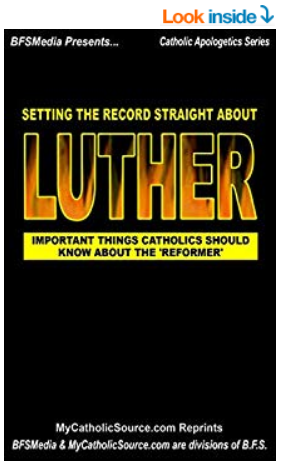
Don't miss this
'eye-opening' treatise concerning Martin Luther, the catalyst / leader of the
' Reformation ' (a.k.a. Protestant Rebellion)
Includes: Facts which demonstrate that Luther
was NOT sent by God, Luther received approval of his teaching from Satan,
Luther's misbehavior, some results of Luther's teachings, Luther admits he could
be wrong, and more...
Get your copy today!
For More Information & To
Purchase, Click Link Below...
Kindle Version Just $5.99
Notice: Prices are subject to change
without notice and do not include any applicable taxes.
Now Available!
BIG Book of Latin Activities For Catholics
Beginning - Intermediate (Vol. 1)

"Suitable For Children Or
Adults!" ~ "Perfect For Home Schoolers!"
+ + +
As many faithful Catholics already know,
the majestic
Latin language – the 'official language' of the Catholic Church –
promotes unity, helps safeguard the purity of doctrine, connects us with
our Catholic ancestors, allows us to pray in "one voice", and even ties
back to the inscription on the Cross which was written in Hebrew, Latin,
and Greek. The Latin language is still used today in the precious
treasure that is the
Traditional Latin ('Tridentine') Mass, in 'everyday speech' (much of
English is derived from Latin), in mottos, in specialized fields, and in
educational endeavors. It has been shown that the study of Latin brings
many benefits. "And, Latin is truly the language of heaven!"
If you enjoy Latin, you may be glad to know that
this full-sized (8.5" x 11"), tradition-minded publication features an
assortment of activity types related to Latin (including: word searches,
crosswords, coloring activities, challenges, fill-ins, spelling bee,
quizzes, unscrambles, true/false, multiple choice, matching, cross-offs,
circling, word associations, translation exercises, and more...), and
treats of various topics (including: common Latin words, Latin language
facts, Latin grammar, nouns & verbs, abbreviations,
phrases / sayings / mottos, prefixes, cardinal numbers, grammatical gender,
inflection, word roots, diacritics / accenting, pronunciation, Latin
prayers / hymns, Scripture verses, Catholic phrases, and more...).
+ + +
" Fun & Educational! "
Get Your Copy Today!
Click Here For More Information & To Purchase
Now Available!
Activity Books For Kindle Scribe

Write-On Books For Scribe!
Click Here For More Information
Try Here For Great Catholic Apps!

My Crucifix
For the iPad®, iPhone®,
and iPod touch®...

For the iPad®...









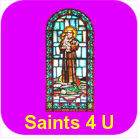



And Other Great Apps...











More My Catholic Source.com Media: Books & Ebooks
|
|
|
|